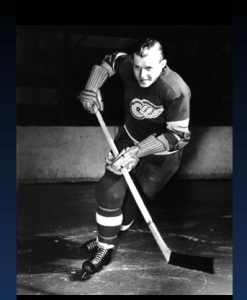The Hockey Hall of Fame announced the addition of 10 new members yesterday. Players named to the Hall are:
- Marty Barry, Boston, Montreal, Detroit.
- Clint Benedict, goalie for Ottawa and Montreal Maroons.
- Arthur Farrell, who played with the Montreal Shamrocks over 50 years ago.
- Red Horner, Toronto Maple Leafs.
- Syd Howe, Ottawa, St, Louis and Detroit.
- Jack Marshall, Montreal Wanderers.
- Bill Mosienko, Chicago Black Hawks.
- Blair Russell, who played with the Montreal Victorias.
- Ernie Russell, Montreal Wanderers in the early 1900s
- Fred Scanlan, also a former member of the Shamrocks.
Earlier this year the hall of fame committee named Toronto television broadcaster Foster Hewitt and Eastern Hockey League president Tommy Lockhart to the builders’ category.
Marty Barry
Marty “Goal-a-Game” Barry was born in Shannon, Quebec, just north of Quebec City in December of 1905. He grew up in Montreal, and that’s where he learned to play hockey. He played in school and intermediate leagues around the city until he caught the eye of New York Americans manager Newsy Lalonde, himself a hockey great. He signed Barry to a contract for the 1927-28 season, but after only nine games, he sent him to Philadelphia of the Can-Am league for more seasoning.
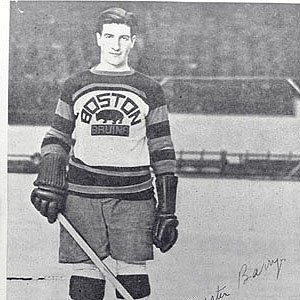
Playing for New Haven of the same league the following season, he led the loop in goals with 19 in 35 games. In May of 1929 the Boston Bruins claimed Barry from the Americans in the Inter-league draft. He spent the next six seasons with the Bruins, developing into a prolific scorer.
In the spring of 1935 he was traded to the Detroit Red Wings with Art Giroux for Cooney Weiland and Walt Buswell. He had four successful seasons with the Wings, playing on one of the NHL’s most formidable lines, with mates Larry Aurie and Herbie Lewis. In 1936-37 he became the first Red Wing to win the Lady Byng Trophy.
Barry played his final NHL season with Montreal Canadiens in 1939-40. He retired having established a reputation as an elite scorer and as a dependable player who rarely missed a game. He was named to the Red Wings Hall of Fame in 1944.
Clint Benedict
Clint Benedict was one of the NHL’s first great “star” goalkeepers. He was born in Ottawa in 1892, and learned his craft on local rinks. He finally made it to his hometown Senators in the 1912-13 season. Benedict quickly established himself as a clutch performer who played through various injuries. He was a scrappy sort, unafraid of doing battle with opposing forwards who took liberties around his net. He also played in the era where goalkeepers were not allowed to fall down to stop the puck. He managed to perfect the art of “accidentally” going to his knees, thus earning the nickname of “Praying Bennie.” His antics led to a relaxation of the rule.
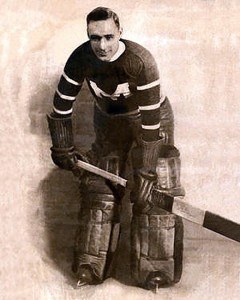
Benedict spent 13 years in the NHL. His first seven seasons were with the Senators, before he was sold to the Montreal Maroons in October of 1924. He played six more seasons in Montreal.
On February 20, 1930, while recovering from a broken nose, and 29 years before Jacques Plante, Benedict played a game against the New York Americans wearing a mask constructed from leather, the first goalkeeper to wear facial protection in the league. He discarded the clumsy-looking apparatus once the nose had healed, saying it impaired his vision.
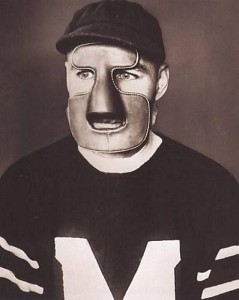
After his stellar NHL career, Benedict spent one season with the Windsor Bulldogs of the International Hockey League before retiring for good. He returned to his native Ottawa where he has worked for many years as a municipal clerk.
Arthur Farrell
Arthur Farrell was born on February 8, 1877 at Montreal Quebec. He attended Montreal St. Mary’s College and eventually graduated to the Montreal Shamrocks. In college he met three players who, along with himself, would become the core of the Shamrocks’ club – Harry Trihey, Fred Scanlan and Jack Brennan.
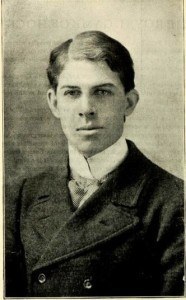
Farrell won the Stanley Cup three times while with the Shamrocks. The high point of his career came in the 1900 playoffs when he scored 10 goals in five playoff games.
Farrell, along with his team mates, quit playing hockey in 1901 after losing the Stanley Cup to a challenge from the Winnipeg Victorias. Farrell took to writing about hockey and published several books. His first, Hockey: Canada’s Royal Winter Game, was printed in 1899. He also contributed to the Spalding sports series of books in the early 1900s. After his playing days, he also worked at his father’s business.
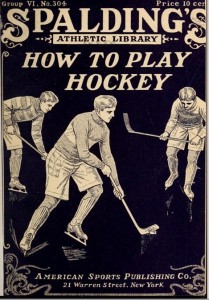
Arthur Farrell fell ill with tuberculosis in 1906 and was confined to a Montreal sanatorium. He passed away there in 1909.
Red Horner
George Reginald (Red) Horner was born in Lynden, Ontario, just west of Hamilton, on May 28, 1909. He grew up to be one of the most feared defencemen in National Hockey League history. He made the Toronto Marlboros junior team in 1926 at age 17 and was earning a reputation, even at that early age, as a rough-and-tumble, take no prisoners kind of player. Marlie captain Shrimp MacPherson described him thusly: “He has his elbow in you kisser or his fanny in your face every time he is on the ice.”
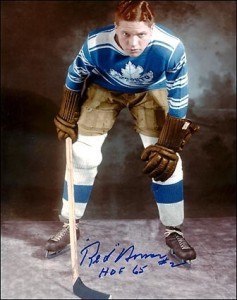
Horner made the Maple Leafs in the 1928-29 season and he would never play anywhere else. He spent 11 seasons with the Maple Leafs, playing in 490 NHL games. He led the league in penalty minutes every season from 1932-33 until his retirement in 1939-40. He set the NHL record for penalty minutes in a season with 167 in 1935-36, a record which would stand for 20 years.
Horner was not offensively gifted, nor was he a great skater. But he was an excellent passer, especially adept at getting the puck out of his defensive zone with a quick, tape-to-tape pass.
Horner was also a complete team player. He risked life and limb in the name of winning, and would do anything for the club. Twice he was called upon to take over as goalkeeper during his career. He was captain of the Leafs the final two seasons of his career.
In retirement he has become a successful businessman.
Syd Howe
Syd Howe was born in Ottawa on September 28, 1911. He learned the game skating on the Rideau Canal before beginning in organized hockey with Glebe Collegiate and later the Lansdowne Park Juveniles. He made it to the Ottawa Gunners junior team in 1927-28.
He was signed by his hometown Ottawa Senators during the 1930 season and played 12 games in his rookie year. The next season, the Senators loaned Howe to the Philadelphia Quakers, for whom he played in their only season of existence. When the Quakers folded, he was taken by the Maple Leafs in the dispersal draft of Philadelphia players. He played only three games for Toronto in 1931-32 and his rights reverted back to Ottawa for the next season.
He became a regular with the Senators for their final two years in Ottawa and moved with the club to St. Louis for the 1934-35 season. He was traded to Detroit by St. Louis with Scotty Bowman for Ted Graham and $50,000 in February of 1935. Howe spent the rest of his NHL career with the Red Wings, becoming one of the league’s top scorers over the next ten seasons.
On February 3, 1944 he set an NHL record when he scored six goals against the New York Rangers. While that record has been equalled several times, it has never been eclipsed.
Jack Marshall
Jack Marshall was born March 14, 1877 in St. Vallier, Quebec. Growing up in Montreal, Marshall played all sports and excelled not only at hockey, but also in rugby, soccer, baseball, lacrosse and bowling. His fine hockey play at Montreal Pointe Charles High School led to his being signed by the Winnipeg Victorias for the 1900-01 season where he scored an amazing 21 goals in 10 games.
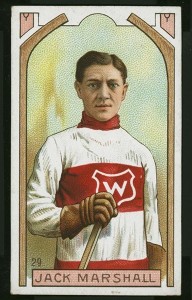
He returned to Montreal the following season to play with the AAA team. An interesting side note was that he was the first player to wear tube skates east of Manitoba, bringing back with him the pair he wore for the Victorias.
Marshall was quite simply, a winner. He is the first man to win the Stanley Cup with four different teams. Those teams were Winnipeg, Montreal AAA, Montreal Wanderers and Toronto Blueshirts. The victory with Toronto came while he was in the role of playing manager.
Marshall finished up his career back in Montreal with the Wanderers in 1916-17, the final year for the NHA.
Bill Mosienko
Bill Mosienko was a 5-foot, 8-inch right-winger born on November 2, 1921 in Winnipeg, Manitoba. He was one of 14 children, with nine brothers and four sisters. He played all of his minor hockey in his home town, eventually graduating to the Monarch junior team.

Mosienko’s first pro season was split between the Providence Reds of the AHL and the Kansas City Americans of the AHA in 1940-41. He spent brief periods of the next two seasons with the Black Hawks before making the team for good in 1943-44. That season was his best, as he netted 32 goals and 38 assists for 70 points in just 50 games. His line mates that year were Clint Smith and Doug Bentley. The unit amassed 219 points, and NHL record for a line in a single season. Two years later Max Bentley took Smith’s place on the line, which was dubbed the “Pony Line.”
Mosienko is most famous for setting the NHL record for the fastest three goals by one player. On March 23, 1952, he scored three times in 21 seconds against the New York Rangers. Linemate Gus Bodnar assisted on all three markers, which were scored against Ranger goalie Lorne Anderson.
Mosienko played his entire career for the Blackhawks, a total of 711 games. He totalled 258 goals and 282 assists. The Hawks sold him to Winnipeg of the WHL on October 23, 1955. Mosienko played four more seasons in his home town with the Warriors, before hanging up his skates for good after the 1958-59 season. He coached the team the following season before leaving the pro game for good.
He spent the following years concentrating on Winnipeg’s minor hockey system and also played for the Manitoba Oldtimers.
Blair Russel
Blair Russel was a life-long resident of Montreal, born in that city on September 17, 1880. He never played professionally, but was as potent a scorer as could be found in any league during his playing years. He spent his entire playing career with the legendary Montreal Victorias, combining with the great Russell Bowie to form one of the more powerful forward duos of that era. He was with the Victorias from 1894-95 through 1909-10. His best season was in 1906-07 when he scored 23 goals and four assists in 10 games. He scored 110 goals in 67 career games.
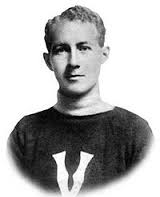
When the Eastern Canada Amateur Hockey Association became a professional league in 1909, Russel refused an offer from the Montreal Wanderers and retired, rather than turn professional.
Russel was known as a very clean player with a flair for offence. he was also adept defensively and a good checker. In a vote conducted by newspapers in Toronto and Montreal, he was named to an all-time All-Star team with other players from that era who were also named to the Hall of Fame.
Ernie Russell
Ernie Russell is another Montreal native who spent his entire playing career in that city. Born in 1883 on October 21, in school he excelled in several sports, principally hockey and football. As a junior, he won national titles in both football and hockey.
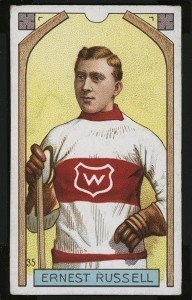
He began his hockey career with the senior-league Montreal AAA, but soon turned professional with the Montreal Wanderers, with whom he played his entire career. He won four Stanley Cups with the Wanderers.
Russell was, like the other players honoured by the Hall from that era, a prolific scorer. In 100 career games, he scored an incredible 176 goals. His best season was in 1906-07 when he notched 43 markers in just 9 games. He scored a hat-trick in five consecutive games during that season.
While playing for the Wanderers, Russell continued his football activities. He was eventually expelled by the club and sat out the 1908-09 season in retirement.
Russell was not a big man, standing only 5-ft., 6-in., and weighing in at only 140 pounds during most of his career. He was one of Montreal’s best-known and most respected athletes during his playing career.
Fred Scanlan
Fred Scanlan was a team-mate of Arthur Ferrell with the Montreal Shamrocks. Like Farrell, he was born in 1877 in Montreal, on May 5. He enjoyed a similarly successful career with the Shamrocks as did Farrell, but he did not quit the game after the loss to Winnipeg Victorias in 1901. Instead, he was so impressed with the Winnipeg team, and they with him, that he joined that club the very next season. He went on to win two more Stanley Cups with the Victorias.

Scanlan was known for his extremely hard shot and for his endurance. It was not unusual to see him skating just as fast at the end of a match as at the beginning, and he rarely left the ice for a rest.
